-
October 2, 2019 by Total Fire and Safety
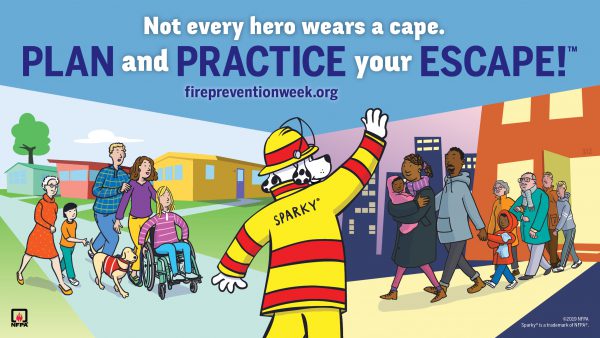
Fire prevention week has been designated as October 6-12, 2019 by the National Fire Protection Association (NFPA). Fire prevention week has a long history, dating back to 1925, when President Calvin Coolidge proclaimed fire prevention week as a national observance. Now, it has become the longest running health observance in the country.
At Total Fire & Safety, we use this time to reiterate to our clients how important it is to stay compliant with NFPA codes and keep everyone within their buildings, warehouses and commercial spaces supplied with fire extinguishers, sprinklers, and suppression systems that are ready to go when fire strikes.
The theme of this year’s campaign is “Plan and Practice Your Escape.” So how can a business observe National Fire Prevention Week? Here’s a few ideas.
- Share safety information from the NFPA with your employees. Not only will it help them at work, but at home too!
- If you do not do so regularly, heed the theme of the program and “plan and practice your escape.” Every employee should be mindful of their best options in the event of an emergency.
- Call your fire protection service for an inspection of your equipment and make sure all your extinguishers, alarms, sprinkler systems, etc. are in working order.
- Consider a training class for fire extinguisher operation, first aid, or CPR.
Around the Total Fire & Safety service area, the observance is being commemorated with lots of events at community fire stations. For more information, see the website for each individual fire department.
Friday, Oct. 4
Saturday, Oct. 5
- Tinley Park Fire Department: 17355 68th Court, Tinley Park, 9 a.m. – 1 p.m. Open House
- Schaumburg Fire Department: 950 W. Schaumburg Road, Schaumburg, 11 a.m. – 2p.m. Public Safety Open House
- Clarendon Hills Fire Department: 316 Park Ave., Clarendon Hills, 11 a.m. – 2 p.m. Open House
- Minooka Fire Department: 7901 E. Minooka Road, Minooka, 11 a.m. – 2 p.m. Open House
- Hazel Crest Fire Department: 2903 W. 175th St., Hazel Crest, 9 a.m. – 12 p.m. Open House
- Frankfort Fire District: 20101 La Grange Road (Event address), Frankfort, IL 60423, 9:30 a.m. – 12:30 p.m. Gas Safety Event
- Palatine Fire Department: 39 E Colfax Street, Palatine, IL 60067, 10 a.m. – 2 p.m. Open House
- Darien-Woodridge Fire District: 7550 Lyman Ave., Darien, IL 60561, 10 a.m. – 1 p.m. Open House
- Oswego Fire Protection District: 3511 Woolley Road, Oswego, IL 60543, 11 a.m. – 3 p.m. Open House
- Calumet City Fire Department: 24 State Street, Calumet City, IL 60409, noon
Sunday, Oct. 6
- Belvidere Fire Department: 123 S. State Street, Belvidere, IL 61008, 1 – 4 p.m. Open House
- Mokena Fire Protection District: 19853 S. Wolf Road, Mokena, IL 60448, 7:30 a.m. – noon Open House
- Lake Zurich Fire Department: 321 South Buesching Road, Lake Zurich, IL 60047, 11 a.m. – 2 p.m. Open House
- Batavia Fire Department: 1400 Main St, Batavia, IL 60150, 11 a.m. – 3 p.m.
- McHenry Township Fire Protection District: 3610 W. Elm Street, District Administration Office, McHenry, IL 60050, 11 a.m. – 1 p.m.
- Naplate Fire Department: 2000 W Ottawa Ave, Naplate, IL 61350, 12 – 3 p.m.
- Manteno Community Fire Protection District, 13 S WALNUT ST, MANTENO, IL 60950, 12 – 3 p.m.
Monday, Oct. 7
- Western Springs Fire Dept: 4353 Wolf Road, Western Springs, IL 60558, 6 – 8:30 p.m. Open House
Wednesday, Oct. 9
- Lombard Fire Department: 50 E St Charles Road, Lombard, IL 60148, 6 – 8 p.m. Open House
- Downers Grove Fire Department: 6701 Main Street, Downers Grove, IL 60516, 6:30 – 8:30 p.m. Open House
Thursday, Oct. 10
Friday, Oct. 11
- South Chicago Heights Fire Department: 185 W Sauk Trail, South Chicago Heights, IL 60411, 5:30 – 7:30 p.m. Open House
Saturday, Oct. 12
- Northbrook Fire Department: 1840 Shermer Road, Northbrook, IL 60062, 9 a.m. – 12 p.m. Open House
- Crystal Lake Fire Rescue: 100 W Woodstock St, Crystal Lake, IL 60014, 9 a.m. – 12 p.m. Open House
- Prospect Heights: 10 E. Camp McDonald Rd, Prospect Heights, IL 60031, 9 a.m. Open House
- La Grange Park Fire Department: 447 N. Catherine Ave., La Grange Park, IL 60526, 10 a.m. – 1 p.m. Open House
- Elgin Fire Department: 650 Big Timber Road, Elgin, IL 60123, 10 a.m. – 3 p.m. Open House
- City of Rockford: 204 S. First St., Rockford, IL 61104, 10 a.m. – 1 p.m.
- Homewood Fire Department: 17950 Dixie Highway, HOMEWOOD, IL 60430, 11 a.m. to 2 p.m.
- Plainfield Fire Protection District: 23748 W. 135th Street, Plainfield, IL 60544, 11 a.m. – 2 p.m. Open House
- Westmont Fire Department: 6015 S. Cass Ave., Westmont, IL 60559, 11 a.m. – 3 p.m. Open House
- Alsip Fire Department: 11946 S. Laramie, Alsip, IL 60803, 1 – 3:30 p.m. Open House
- Calumet City Fire Department, Station 2: 1270 Pulaski Rd, Calumet City, 12 – 3 p.m. Open House
Sunday, Oct. 13
- North Palos Fire Protection District: 10629 S Roberts Rd, Palos Hills, IL 60465, 7 a.m. – 12 p.m.
- Byron Fire Department: 123 S. Franklin St., Byron, IL 61010, 11 a.m. – 3 p.m. Open House
- Elmhurst Fire Department: 601 S York, Elmhurst, IL 60126, 12 – 4 p.m. Open House
Wednesday, Oct. 23
- Chicago Ridge Fire Department: 10063 Virginia, Chicago Ridge, IL 60415, 6 – 9 p.m.
Fire protection and preparation is not just a week-long observance but a 365 day a year, 24/7 job. At Total Fire & Safety, we have everything you need to keep your employees and tenants protected. If we can ever assist your business with NFPA compliance for your commercial fire protection, contact us at 630-960-5060.
Category: Business Safety, Fire Equipment Inspections, Fire exits, Fire News, Fire Safety, Health and Safety, LED Lighting, NFPA Compliance, Total Fire and Safety Tags: commercial fire safety, emergency exit lights, fire and safety equipment, fire and safety needs, fire and safety solutions, fire safety in the news, lifesafety | Comments Off on 2019 Fire Prevention Week is for Businesses Too!
-
April 24, 2019 by Total Fire and Safety
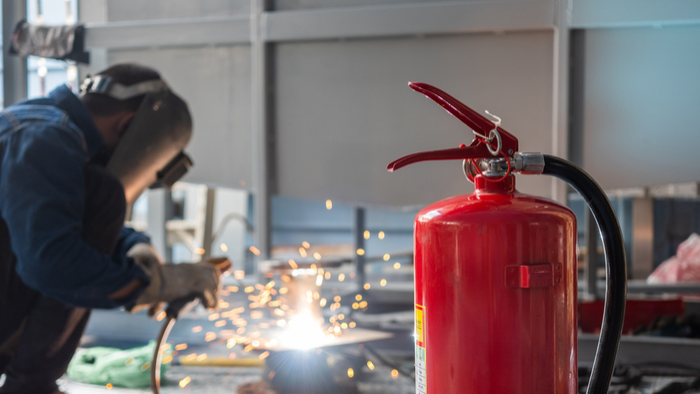
According to the National Fire Protection Agency (NFPA), between 2011 and 2015, there was an estimated 37,910 fires at industrial properties each year. These industrial fires resulted in 16 civilian deaths, 273 civilian injuries, and $1.2 billion in property damage.
Industrial fires are serious, but there are several things you can do at your plant or factory to minimize the possibility of an industrial fire. First, it’s important to know how they usually start.
The five most common causes of industrial fires are…
1. Combustible Dust Fires
A combustible dust is any dust or fine material that has the potential to catch fire and explode when it is mixed in the air. Many times, materials that are normally considered non-flammable can act as a combustible when fine particles are mixed with air in a particular concentration. Combustible dust happens in two waves. A primary explosion causes particles to become airborne, and then the dust cloud can ignite and cause a secondary explosion, much more severe than the first. Combustible dust can bring down entire facilities.
How do I Prevent Combustible Dust Fires?
- Implement a hazardous dust inspection, testing, housekeeping, and control program.
- Regularly inspect for dust residues in open and hidden areas.
- Use proper dust collection systems.
- If ignition sources are present, use cleaning methods that do not generate dust clouds.
- Control smoking, open flames, and sparks (mechanical and friction).
2. Hot Work Fires
Hot work is any activity that involves open flames or generates sparks or heat. This includes welding, heat treating, grinding, thawing pipes, torch cutting, brazing, soldering, etc. Hot work becomes a fire hazard when sparks and molten material travel…often as far as 35 feet, sometimes igniting combustible dust in other areas.
How do I Prevent Hot Work Fires?
- Train personnel on the hazards associated with hot work and make sure they are using proper safety equipment.
- Clear area of flammable materials including dust, gases, and liquids.
- Make sure a safety professional is on site to provide supervision of the work.
- Avoid hot work if possible.
3. Flammable Liquid and Gas Fires
These are most common in chemical plants. Flammable liquids and gases can ignite off sparks from the previous hazards or add fuel to an already burning fire.
How Do I Prevent A Flammable Gas Fire?
- Know the hazards of each flammable liquid and gas on-site. Read and follow the safety information for storage and follow the material safety data sheet included with the product.
- Properly store hazardous materials according to OSHA.
- Keep ignition sources away from flammable gases and liquids.
- Provide personal protective equipment, like gloves, bodysuits, vests, goggles, shoes etc.
4. Equipment and Machinery Fires
Equipment not properly installed, maintained, or operated correctly is a major cause of industrial fires. This is especially true for equipment associated with hot work and heating. Even machinery not seen as a fire hazard can become a risk with lack of proper maintenance.
How Do I Prevent Equipment and Machinery Fires?
- Training can help employers and employees identify possible risks and what to do if they find one.
- Keep the machines, equipment, and areas surrounding them, clean.
- Prevent machine overheating by following the manufacturer’s guidelines for recommended maintenance procedures.
5. Electrical Hazard Fires
Electrical fires are most common in manufacturing plants and include wiring that is exposed or not up to code, overloaded outlets, extension cords, overloaded circuits, static discharge, etc. A spark from electrical hazards can cause ignition of combustible dust and flammable liquids and gases.
How Do I Prevent Electrical Hazard Fires?
- Don’t overload electrical equipment or circuits.
- Unplug temporary equipment not in use.
- Avoid using extension cords.
- Use antistatic equipment as advised by OSHA and NFPA.
- Follow a regular cleaning schedule to ensure combustible dust and other hazardous materials are removed from areas that house equipment and machinery.
It can seem overwhelming to have to safeguard your facility against industrial fire hazards, but the pros at Total Fire and Safety can help you identify and prevent risks throughout your facility. They also provide fire safety training to educate employees on proper fire safety equipment operation and life safety procedures.
To take the first step in keeping industrial fires at bay at your facility, call Total Fire and Safety at 630-960-5060 or reach us at our 24/7 emergency line, 630-546-8909.
Category: Business Safety, Fire Safety, NFPA Compliance Tags: commercial fire protection, commercial fire safety, fire and safety solutions, fire safety training, Industrial Fire Prevention, Industrial Fire Safety, Total Fire & Safety | Comments Off on The Best Way to Prevent Industrial Fires
-
February 27, 2019 by Total Fire and Safety
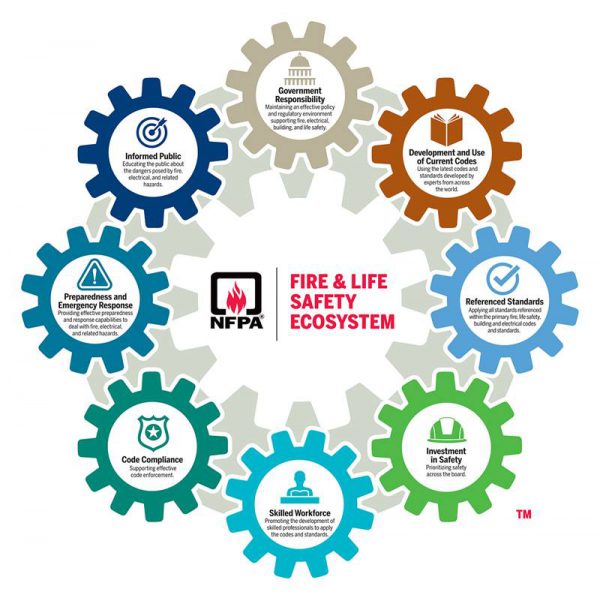 Image: NFPA Website The fire and life safety ecosystem led the discussion at the 2018 NFPA Conference and Expo. What is the fire and life safety ecosystem? Like any ecosystem, it is comprised of elements that work together to achieve a functioning system—in this case, eight separate elements that have to do with fire and safety. Several of them are the responsibility of the government, while many call upon the public to enforce and deliver. Regardless of who is charged with the responsibility, the goal throughout the ecosystem is to prevent major disasters from fire, electrical, and other hazards. When tragedies occur, it is likely there was a breakdown in one or more parts of the fire and life safety ecosystem. Here are the eight components relating to the fire and life safety code:
- Government Responsibility: Policy makers must maintain effective policy and regulatory environment and not prioritize politics over the public’s safety. When life safety codes are stripped for any reason, people’s lives are endangered for the sake of political gain.
- Development and Use of Current Codes: Government and building designers must implement the latest codes and standards or risk losing the latest technology and research in fire, electrical, life safety.
- Referenced Standards: All standards within the fire, life, building, safety, and electrical codes must be addressed or the right products and practices will not be used, possibly leading to disastrous results.
- Investment in Safety: Property managers and need to make an investment in safety to comply with the latest standards and codes. Hiring a company like Total Fire and Safety means an investment in safety. All the latest fire safety technologies are always available from TFS and we can design a program to fit any company’s needs and budget.
- Skilled Workforce: Promote the development of skilled professionals to apply the codes and standards. For over 20 years, TFS has employed highly skilled, highly trained, and highly dedicated workers in order to put customers’ safety above all else.
- Code Compliance: Effective code enforcement is necessary. Fire Marshalls and other officers must conduct regular inspections to ensure safety and code compliance.
- Preparedness and Emergency Response: Provide effective preparedness and emergency response capabilities to deal with fire, electrical, and related hazards. Train employees on emergency equipment, fire safety drills, designated leader in emergencies, etc.. TFS provides training classes for employees, as well as, informative literature on how to react in an emergency and much more.
- Informed Public: Educating the public is important, as is educating businesses about the specific fire hazards in their facilities.
No one cog in the fire and life safety ecosystem can keep us all safe from harm. Even all the pieces together, working in tandem, may not prevent every disaster, but they can certainly prevent many. By practicing and implementing the various areas outlined in the fire and life safety ecosystem, we can all create a safer community. At Total Fire and Safety, we are committed to helping you play your role in the fire and life safety ecosystem. Contact us today to discuss your fire safety needs or call 630-960-5060.
Category: Business Safety, Fire code violation, Fire Safety, Health and Safety, NFPA Compliance, Total Fire and Safety Tags: fire and safety equipment, fire and safety needs, fire and safety solutions, fire safety solution, fire safety training, Total Fire and Safety | Comments Off on What’s a Fire and Life Safety Ecosystem?
-
May 30, 2018 by Total Fire and Safety
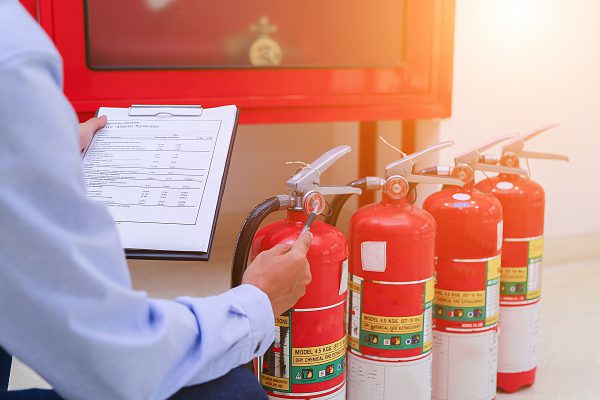
Most companies understand the mandate to have regular fire extinguisher inspections but many wonder why on earth a company could actually fail these inspections. After all, a fire extinguisher is rarely used so how can it need service?
Chances are you see a fire extinguisher every day, but how closely do you look at it? Even one dent in the tank can change the outcome. According to the NFPA, nearly 30 percent of fire extinguishers are not in proper working order. Total Fire and Safety’s twelve-point check can ensure your company’s compliance. However, there are five main reasons why companies fail a fire extinguisher inspection.
1. Unseen Damage– Corrosion or damage can occur over time in hard to see areas of the extinguisher, for example, rust within the tank. That is when a professional steps in and inspects the extinguisher inside and out. TFS will visually examine the extinguisher making sure it is free of dents, rust, or other hazards.
2. Potential Hose Blockage– Debris can clog the hose or deterioration of the O-rings can occur over time, rendering a fire extinguisher useless in an emergency. TFS will remove the hose completely to check for irregularities.
3. Possible Leaks– Whether large or small, a leak will cause the fire extinguisher to be inoperable. Anyone can check the pressure gauge to determine if there is a leak. However, if there is no pressure gauge, you will need a professional. TFS will confirm the compression in the tank.
4. Wear/Fading of Labels– Labels are vital when fighting a fire because they contain instructions on how to use the extinguisher. They also provide important information about the device’s maintenance history, which is needed by inspection professionals. Once your fire extinguisher inspection is complete, the labels will be updated, and an additional certification tag will be attached.
5. Recharging Needed– Once a fire extinguisher is used, even partially, it will need to be recharged immediately. If you fail to recharge the extinguisher, it will fail you in a fire.
Although these are common reasons companies fail fire extinguisher inspections, there are other possible hazards not listed. It is important to stay up-to-date with your fire extinguisher inspections. The NFPA requires inspection every month and maintenance every year by a professional. In addition, a stored pressure extinguisher requires internal maintenance every six years and a hydrostatic test every 12 years.
It takes a minute for a fire to spread and cause irreparable damage to your company—the same amount of time it takes to schedule a fire extinguisher inspection!
Total Fire and Safety can inspect your fire extinguishers to ensure they are unfailingly ready to fight fire at a moment’s notice. We also provide onsite training for your employees, including hands-on practice in the use of a fire extinguisher. Give us a call today at 630.960.5060.
Category: Business Safety, Fire code violation, Fire Equipment Inspections, Fire Extinguishers, Fire Extinguishers, Fire Safety, NFPA Compliance, Total Fire and Safety Tags: equipment, Extinguisher, fire and safety equipment, fire and safety needs, Fire Extinguisher, fire extinguisher inspections, fire safety, safety, Total Fire & Safety, Total Fire and Safety | Comments Off on Why Companies Fail Fire Extinguisher Inspections
-
March 15, 2018 by Total Fire and Safety
 Nobody thinks much about emergency exit lights. But if the power suddenly goes out, smoke fills the room and you can’t see a foot in front of you, relying on the emergency lights may be your only means of escape. Nobody thinks much about emergency exit lights. But if the power suddenly goes out, smoke fills the room and you can’t see a foot in front of you, relying on the emergency lights may be your only means of escape.
Emergency exit lights are essential to safety in any dangerous situation. They can alarm someone in a fire, be the only source of light in the dark, and the key to safely exiting the building. Emergency exit lights are often overlooked and taken for granted, but take note of how many you come across every day. Do you realize how many requirements and regulations go into the installation and maintenance of one exit sign?
There are numerous agencies that govern emergency exit lighting and signs: OSHA (Occupational Safety and Health Administration), NFPA (National Fire Protection Administration, JCAHO (Joint Commission on Accreditation of Healthcare Organizations and the International Building Code and International Fire Code. Above all these agencies, the local authority is responsible for monitoring and enforcing building/fire codes.
According to OSHA, an exit route is defined as a continuous and unobstructed path of exit travel from any point within a workplace to a place of safety. There are three parts to an exit route:
- Exit access-part of the exit route that leads to an exit.
- Exit-part of the exit route that is separated from other areas and provides a safe means of travel to exit discharge.
- Exit discharge-part of the exit route that leads to directly outside or refuge area.
OSHA’s requirements for the lighting of these afore mentioned exit routes is covered under 1910.37(b). It states that each exit route must be sufficiently lighted so an employee with normal vision can see along the exit route and each exit must be clearly visible and marked by a sign reading “EXIT.” Additional information for OSHA requirements can be found at www.osha.gov.
The NFPA guidance for emergency exit lighting and signs can be found in the NFPA 101, Life Safety Code. The NFPA’s Life Safety Code provides information for placement, illumination, and visibility for exit signs.
- Placement of exit sign. Any exit signs must be located so that no point in an exit access area is more than the sign’s viewing distance, or 100 feet from the nearest sign.
- Visibility of exit signs-Every sign must be located and of such size, distinctive color and design that is visible and contrasts from the background of its placement. NFPA also states no decorations, furnishings, or equipment that impairs visibility of a sign shall be permitted. Nothing should be placed near an exit sign that distracts attention and inhibits visibility of an exit sign.
- Illumination of Exit Signs-The NFPA states all exit signs must be illuminated by a reliable light source and legible in normal and emergency exit lighting modes. There are two categories of illumination: external illumination, which comes from outside the exit sign and internal illumination, which comes from a source inside an exit sign.
According to the NFPA, emergency illumination must be provided for a minimum of 1.5 hours in the event of power outage. The emergency lighting must be illuminated not less than an average of one lumen per square foot. The maximum illumination at any point can be 40 times the minimum illumination. All emergency exit lighting must be able to provide lighting automatically when normal light is interrupted.
Many emergency exit lights are now using LED lights. The NFPA states that LED lights are longer lasting, provide better light and are most durable. In emergency situations, LED lights emit sufficient lighting and are most effective when placed properly. They are also most energy efficient, saving the building money.
According to the NFPA requirements for testing, there are three categories of emergency lights: traditional, self-testing, and computer base self-testing. A monthly activation test which involves having the lights illuminate for no less than 30 seconds and an annual test which keeps the lights illuminated for 1.5 hours, simulating a long-term emergency. Records of these test must be maintained for inspection.
Many regulations, codes, and considerations go into the signs and lights you see every day so it is important to have regular maintenance and testing of these lights. Total Fire and Safety has a knowledge team for inspecting emergency exit lighting. With regular maintenance and testing from Total Fire and Safety, you can be assured your emergency exit lighting is up to code and the safety of your employees/tenants is assured. Give us a call today 630-960-5060.
Category: Business Safety, Fire code violation, Fire Equipment Inspections, Fire exits, Fire News, Fire Safety, Health and Safety, LED Lighting, NFPA Compliance, Total Experience, Total Fire and Safety Tags: commercial fire protection, commercial fire safety, emergency exit lights, emergency lighting, fire and safety equipment, fire and safety needs, fire and safety solutions, fire safety in the news, fire safety solution, fire safety training, lifesafety, safety | Comments Off on Are You In the Dark About Emergency Exit Lights?
-
December 19, 2017 by Total Fire and Safety
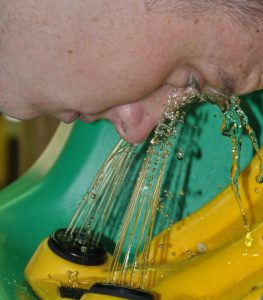 If you have hazardous chemicals onsite, you likely need an emergency eyewash station. One of the many vital services we provide at Total Fire and Safety is performing inspections on emergency showers and eye wash stations. Like any fire or safety equipment, routine inspections are a must to ensure your equipment will perform perfectly at a moment’s notice. In an emergency situation, nobody has the time troubleshoot an underperforming piece of equipment, let alone attempt to repair it. We’ve outlined the steps we take to ensure your eye wash station or emergency shower is ready in an emergency:
1. Ensure everything about the station’s location is correct. We first make sure the station is in an area it is needed. A working emergency eye wash station is of no use if it is not accessible to those who may need it. While showers tend to be fixed structures, eye wash stations can be either fixed or mobile. We also make sure the station is unobstructed and away from any source of debris or hazardous spray, which could compromise its usefulness.
2. Next, we inspect the exterior. We visually check every part of the station for any signs of damage, such as leaks, cracks, or other signs. Then, we check that all the hardware is intact and correctly in place, such as the caps, valves, and pull rods for showers. We then verify everything is at the correct height and that all signage is in its proper place before moving on to the next step.
3. After the visual inspection, we test the operation. For every eye wash station, we check the flow of water by gauging its height, volume, and response time from the moment of activation. For showers, we verify the water flows properly and onto the correct area.
4. For portable units, we empty and replace the water. This is to ensure the water in the reservoir is not only full, but clean and fresh. This step is also taken so that we can rinse out the inside as well as check for foreign debris or contaminants which could compromise the integrity of the eye wash station.
5. Finally, we clean everything and document the inspection. This entails wiping everything down with a rag and cleaning solution. Once this is done, we apply the inspection tag to the station to communicate to others when the inspection took place and what was performed. We also keep our own records of the inspection by filling out detailed information in an eyewash report.
In any facility that may contain hazardous substances, you may find an emergency shower or eye wash station idly waiting until needed. These units are not given much thought, but anyone who has ever used one in an emergency situation will vouch for its importance to stay in proper working order. If you have any questions or concerns about your emergency eye wash station or shower, or about the readiness of any of your fire safety equipment, please contact us.
Category: First Aid, Health and Safety, NFPA Compliance, Total Fire and Safety, Uncategorized Tags: fire and safety equipment, first aid, first aid supplies, Health and Safety, Total Fire & Safety | Comments Off on Are Your Emergency Eye Wash Stations Ready for Action?
-
November 29, 2017 by Total Fire and Safety
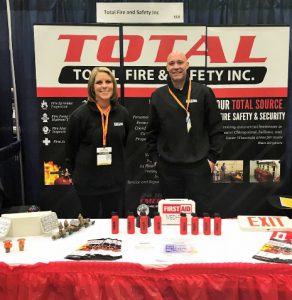 Robin Jones, business development (left) and Jason LeGrand (outside sales) at the latest Co-op and Condo Expo at Navy Pier in Chicago. Did you stop by and see us at the latest Co-op and Condo Expo at Navy Pier in Chicago?
Our team was on hand to talk to condo owners, homeowner association board members, property managers and apartment building owners about their fire safety. We participate every year, not only to meet new prospective clients, but to see our many satisfied ones that come for the educational seminars and exhibit floors.
Visitors to our booth walk away with one of our fire extinguisher-shaped stress balls (if you don’t have one, ask your Total Fire & Safety technician!) and a better understanding of their fire safety responsibilities as property owners or managers. What were the most frequently asked questions?
- How do I know if I am in compliance? (We can help perform inspections to make sure buildings are up-to-date with NFPA requirements, which vary depending on your structure and occupancy.)
- What is this wireless fire alarm technology and will it save me money? (Besides making sure your fire alarms are inspected, in compliance and operational, we can update your old equipment to reduce maintenance costs and improve performance.)
- What do my tenants need to know about fire safety? (We offer solutions and fire safety training on a customized basis.)
- Do you offer first aid kits? (We offer a variety of commercial first aid kits based on your environment’s needs. A first aid kit can make a big difference in the comfort and safety of your tenants or employees!)
- Why Total Fire & Safety? (We are one of the most experienced commercial fire protection companies on the market and make use of some of the most technologically advanced reporting features available.)
We hope to see you at the show next year! Until then, if we can be of assistance with your fire safety needs, don’t hesitate to contact us at 630.960.5060.
Category: Business Safety, Client Events, Fire Safety, NFPA Compliance, Total Fire and Safety, Uncategorized Tags: client events, commercial fire protection, commercial fire safety, Events, fire and safety needs, Total Fire & Safety, wireless fire alarms | Comments Off on TFS at the Co-op and Condo Expo
-
October 31, 2017 by Total Fire and Safety
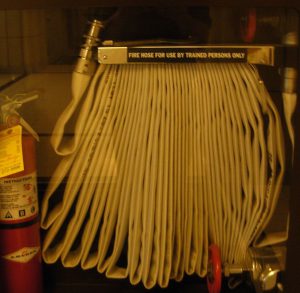 All fire safety equipment is subject to rigorous standards for safety and reliability, and fire hoses—the subject of NFPA 1962—are no exception. Despite looking like a relatively simple device, a fire hose is one of the most important lines of defense in firefighting. NFPA 1962 is an important revised standard for fire hoses; an outline which ensures that all hoses and their components will perform safely and as expected. At Total Fire and Safety, we take pride in ensuring that every fire hose meets all safety specifications. All fire safety equipment is subject to rigorous standards for safety and reliability, and fire hoses—the subject of NFPA 1962—are no exception. Despite looking like a relatively simple device, a fire hose is one of the most important lines of defense in firefighting. NFPA 1962 is an important revised standard for fire hoses; an outline which ensures that all hoses and their components will perform safely and as expected. At Total Fire and Safety, we take pride in ensuring that every fire hose meets all safety specifications.
NFPA 1962 Fire Hose Pre-Inspection
Before the inspection begins, we ensure the hose is easily accessible in all directions, and that there is a clear path to it. If the time comes to use a hose, there will be no time to clear obstructions. After this, we remove the cover from the hose and inspect the nozzle first, ensuring it opens and closes freely.
NFPA 1962 Inspection
First, we unravel the hose by the nozzle and find the tags and markings which indicate such information as the hose’s manufacture date and when it was last inspected. Once the hose is unraveled, we perform a visual inspection of the hose, inside and out, looking for any signs of wear or damage. This can be anything from cuts, to frays, to dry rotting, to contamination by a foreign substance. According to NFPA 1962, if there is any issue with the hose, we ensure it is either hydro tested or replaced. We also check the hose to ensure it is completely dry, inside and out. If we find evidence of water, we perform a hydro test to verify the hose is still up to code.
NFPA 1962 Post-Inspection
Once the inspection is complete, we carefully re-rack it to ensure it does not crack, fray, or wear prematurely over time. We also reconnect the hose to the standpipe and close the nozzle. We conclude the inspection by replacing the cover around the hose and documenting our procedure by placing an inspection tag around the standpipe.
At Total Fire and Safety, our inspectors are fully trained and up-to-date in all safety regulations—including NFPA 1962—to ensure your facility is safe and up to code. If you have any questions about your own facility’s fire preparedness, or if you are due for an inspection, don’t hesitate to contact us.
Category: Fire Hoses, Fire Safety, NFPA Compliance, Total Fire and Safety Tags: commercial fire safety, fire and safety equipment, Fire Hose Inspection, Fire Hoses, fire safety, NFPA, NFPA 1962, Total Fire & Safety | Comments Off on Are your Fire Hoses Compliant with NFPA?
|

|
|
|
|
|
|

 Facebook
Facebook
 Instagram
Instagram
 LinkedIn
LinkedIn



 Nobody thinks much about
Nobody thinks much about 

 All fire safety equipment is subject to rigorous standards for safety and reliability, and fire hoses—the subject of NFPA 1962—are no exception. Despite looking like a relatively simple device, a fire hose is one of the most important lines of defense in firefighting. NFPA 1962 is an important revised
All fire safety equipment is subject to rigorous standards for safety and reliability, and fire hoses—the subject of NFPA 1962—are no exception. Despite looking like a relatively simple device, a fire hose is one of the most important lines of defense in firefighting. NFPA 1962 is an important revised 